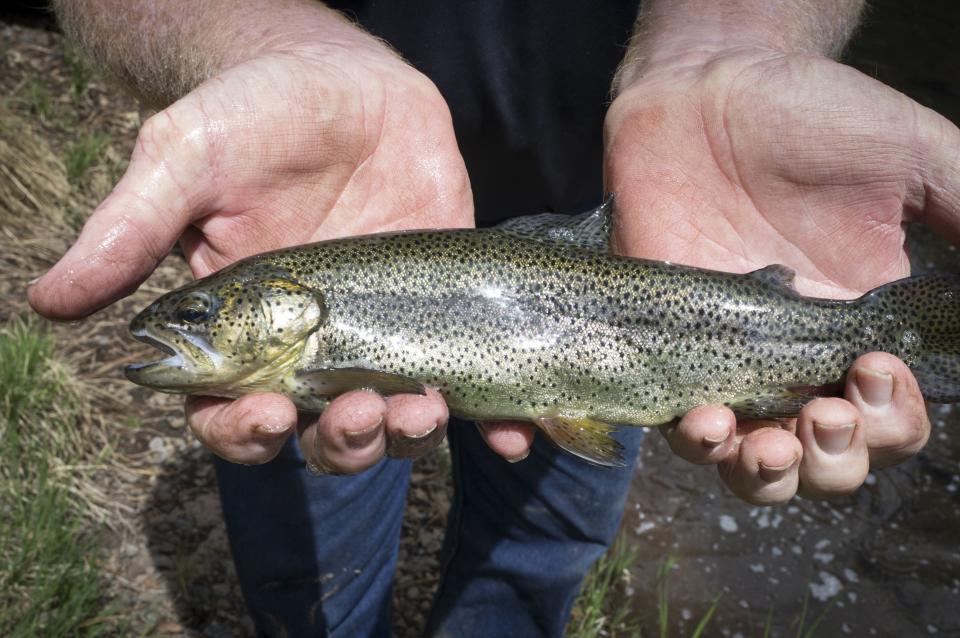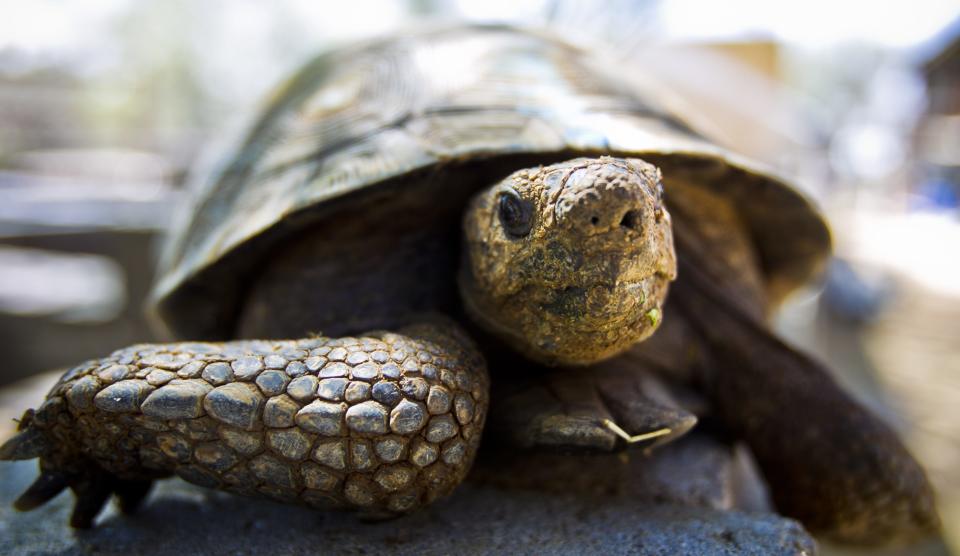Jaguars, leopard frogs, condors: Here are some of Arizona's most imperiled species
Herds of bison graze on the North Rim of Grand Canyon National Park, endemic fossil spring snails cling to rocks found only in streams in parts of the Coconino National Forest, and bald eagles spread their wings over Roosevelt Lake.
Arizona holds an ecologically diverse and abundant landscape that is home to thousands of species of wildlife that can be found everywhere from the cool high country in the White Mountains to the warmer deserts of Phoenix and Tucson.
Friday is the United Nations' World Wildlife Day, meant to celebrate the importance of all forms of flora and fauna. The theme for 2023 is “Partnerships for Wildlife Conservation.”
The day is an opportunity to highlight some of the rare species that provide integral roles in their regions of the state. In Arizona, there are 72 endangered or threatened species and with every species lost, conservationists say, comes peril to another. State and federal agencies, conservation groups, wildlife advocates, scientists and environmentalists have helped develop recovery plans for species in danger to ensure they don't disappear from the ecosystem.
Here are some of the state’s most fascinating critters who are federally listed as endangered or threatened, their history, and their fight for survival.
'El Jefe' among 7 jaguars spotted in AZ in past 25 years

Their range once expanded in the U.S. from Louisiana to California, but today jaguars only occupy a small portion of that area. Federally listed as endangered since 1972, the large cat is believed to only roam the U.S. side of the border in an area south of Interstate 10. Habitat fragmentation, climate change and the border wall all remain major threats to the species' survival. In the last 25 years, only seven jaguars have been spotted in Arizona. “El Jefe,” meaning "the boss," is the only verified jaguar to remain in the U.S. and has not been seen in Arizona since 2015. In August 2022, El Jefe reappeared on a motion-detector camera in the Mexican state of Sonora.
'Lil' Jefe' believed to be Arizona's last known ocelot
“Lil’ Jefe,” or "lil’ boss," is believed to be the last remaining ocelot in Arizona, cut off from other populations of its species by the border wall. Ocelots were once abundant in the high Sonoran Desert, but their numbers plummeted as hunters sought their fur and urbanization encroached on their habitat. Lil’ Jefe was last spotted in the Huachuca Mountains in 2021. The spotted cat is still common in South America, although habitat destruction and deforestation are threatening the species there as well.
Mexican gray wolf sees comeback after breeding program introduced
The Mexican Gray wolf is the rarest subspecies of gray wolf in the U.S. Though they once numbered in the thousands, the wolves were nearly entirely wiped out by the 1970s. An interagency Mexican Wolf recovery team was formed and a breeding program was established, and in 1998, the first wolves were released back in the wild. Now, 25 years later, the number of wolves in the wild has surpassed 200.
Black-footed ferret, only native ferret to North America

The black-footed ferret is one of the most endangered mammals in North America. The only native ferret found on the continent, the species was believed to be extinct until 1981, when it was rediscovered on a Wyoming ranch by a dog named Shep. The U.S. Fish and Wildlife Service began an intensive search and discovered a population of more than 100 ferrets. These animals were left on the ranch where they were closely monitored until a plague and canine distemper outbreak caused population numbers to plummet to 18. Reintroduction began in Arizona in 1996 after a 60-year hiatus and around 350 black-footed ferrets remain in the wild as of 2022.
The 'desert ghost': Sonoran pronghorn

Known as the “desert ghost,” the Sonoran pronghorn is endemic to the Sonoran Desert. They are the fastest land mammal in North America, reaching speeds up to 60 mph. The Sonoran pronghorn was extirpated from its range in California by the 1950s due to overhunting, fencing and water source development. In 2002 only 21 Sonoran pronghorns remained in Arizona. A semi-captive binational breeding program with Mexico has helped the species recover, and there are now roughly 400 Sonoran pronghorn in the state.
The largest cyprinid fish in North America, the Colorado pikeminnow
The Colorado pikeminnow is the largest cyprinid fish in North America, with reports of the fish growing up to 6 feet long. The fish is native to the Colorado River Basin and was formerly an important source of food for Indigenous communities. Their range has been significantly reduced due to dewatering, altered streamflow and diversion, poor water quality and silt loads. The fish is now extinct in Mexico and threatened in the U.S. A draft recovery plan last year projected a cost of nearly $180 million over 15 years to recover the species through management of water flow, maintenance of fish passages and control of nonnative species, among other measures.
Apache trout, one of the first species listed under Endangered Species Act

Arizona’s state fish, once known as yellowbelly for its distinct gold underside, was one of the first species listed under the Endangered Species Act. It can only be found in the White Mountains of eastern Arizona. An integral part of the White Mountain Apache Tribe history, the fish nearly went extinct in the mid-20th century due to overfishing and introduction of invasive species. The Apache trout is on the road to recovery and last year, the U.S. Fish and Wildlife recommended delisting the species due to successful conservation and restocking efforts.
Gila trout successfully reintroduced to Arizona
A close relative of the Apache trout, the Gila trout can be identified by the dark spots on its back. One of the rarest subspecies of trout in the world, the fish was downlisted from endangered to threatened in 2006. While its historic range is unknown, it is believed the fish were once abundant in rivers throughout the state and in high elevations. By the 1950s the fish was completely wiped out in Arizona, and only survived in the Gila River’s headwaters in New Mexico. Restocking and conservation efforts have brought the fish back to Arizona and its numbers are on the rise.
Northern aplomado falcon returns to the Southwest
This long-tailed and long-winged falcon catches birds and insects in midair and hunts lizards and small mammals on foot. Characterized by a distinctive black-and-white facial pattern, the northern aplomado falcon went extinct in the wild by the late 1950s. The Peregrine Fund and other conservation groups began a breeding program and reintroduced the birds to the wild by the late 1980s. Today more than 1,500 of the birds have been released back into the Southwest and their numbers continue to rise.
California condor, once extinct in the wild, found in northern Arizona

The largest North American land bird was also once extinct in the wild. Lead ammunition is believed to be the main driver in the decline of the California condor. But breeding programs and reintroduction have given bird enthusiasts hope, and today more than 500 of the birds live in the wild or in captivity. California condors can be found in northern Arizona, and each year a release is open to the public at Vermillion Cliffs National Monument.
Southwestern willow flycatcher protected along San Pedro river
Usually smaller than six inches, this little bird plays a big role in controlling insect populations around wetlands and waterways. The species has been listed as endangered since 1995 and roughly 900 breeding pairs remained in the state by 2002. Riparian habitat along state rivers is critical for the bird’s survival, but climate change, livestock grazing and habitat loss have all contributed to the bird's decline. The San Pedro Riparian National Conservation Area protects expansive critical habitat for the bird along the San Pedro River.
Sonoyta mud turtle newest species on endangered species list
The Sonoyta mud turtle evolved as an aquatic species in one of the driest parts of the Sonoran Desert. They are the state’s newest inductee to the endangered species list and the turtles were granted critical habitat protection in 2020. Decreased water flow, ground pumping of water and extended drought put the species' survival in danger. A group of 10 healthy mud turtles hatched at the Desert Museum show how the reptiles could continue to survive in the face of climate change.
Desert tortoise threatened, not at risk for extinction

Native to both the Mojave and Sonoran deserts, these giant tortoises can live up to 80 years. The desert-adapted creature has been threatened by habitat destruction, disease, illegal collection and other factors. While it remains a threatened species, in its latest scientific assessment, the USFWS determined the species is not at risk for extinction in the foreseeable future. Despite urbanization and construction of highways, desert tortoises still maintain much of their historic range today.
Narrow-headed garter snake a species of "least concern"

Growing up to four feet long, the narrow-headed garter snake can be found in central Arizona east into New Mexico along rocky creeks and streams. The species has seen significant population declines in recent years but is classified as a species of “least concern” because of its wide range. Invasive species and habitat loss are the main drivers of the species' decline. The Center for Biological Diversity has filed several lawsuits in recent years to protect the snake’s riparian habitat crucial for its survival. The narrow-headed garter snake also finds refuge in the San Pedro Riparian Conservation Area.
Sonoran tiger salamander surviving in only 50 ponds
First added to the endangered species list in 1997, this salamander can only be found in a small region of Southern Arizona and New Mexico. Their most important habitat requirement is year-round availability of standing bodies of water for breeding, growth and development. Permanent bodies of water can also provide good habitat for invasive fish and bullfrogs that prey on the salamanders' eggs and larva. Severe and rapid erosion caused water habitats to disappear and, as a result, ponds created by ranchers for watering livestock are almost the only good breeding sites left for Sonoran tiger salamanders. They are believed to be found in about 50 ponds in Cochise and Santa Cruz counties.
Chiricahua leopard frog slowly recovering
Once found in more than 400 aquatic sites in the Southwest, the Chiricahua leopard frog is now found at fewer than 80. The frogs need permanent water for reproduction which is increasingly difficult to come by due to drought, groundwater pumping, diversion and livestock grazing. While their numbers have declined in recent decades, since they were added to the endangered species list in 2002, their protected habitat has expanded and their numbers are believed to be on the rise.
Huachuca water umbel threatened by disappearing wetlands
Once a flourishing part of extensive riparian habitats in southeastern Arizona and northern Sonora, Mexico, the Huachuca water umbel has been reduced to a handful of discontinuous clumps in a few Southwest wetlands. First listed as endangered in 1997, the plant has a unique ability to expand its population quickly after a flood, but a lack of refugia — places that let it escape the effects of flood — and disappearing wetland habitat is threatening the species. The San Pedro River, one of the umbel's main habitats, is drying up due to excessive groundwater pumping and population growth in southeastern Arizona. Riparian vegetation along the San Pedro is also threatened by livestock grazing, drought and wildfire.
Acuña cactus especially vulnerable to habitat loss
The acuña cactus is a small, perennial plant in the cactus family known for its pink to lavender-colored flowers. Extensive prolonged drought is likely responsible for the recent declines in population. First listed in 2013, the species is especially vulnerable because it occurs in just eight populations. USFWS has been working in recent years to introduce and reintroduce the cactus to suitable areas.
Gierisch mallow threatened by gypsum mining
This endangered plant is only found in Utah and Arizona and was listed as endangered in 2013. The tall plant is highly imperiled because its range is being mined by gypsum, used to manufacture sheet rock. Off-road vehicles, illegal dumping, invasive plants and livestock grazing also continue to threaten this species of plant.
Jake Frederico covers environment issues for The Arizona Republic and azcentral. Send tips or questions to jake.frederico@arizonarepublic.com.
Environmental coverage on azcentral.com and in The Arizona Republic is supported by a grant from the Nina Mason Pulliam Charitable Trust. Follow The Republic environmental reporting team at environment.azcentral.com and @azcenvironment on Facebook, Twitter and Instagram.
Support environmental journalism in Arizona. Subscribe to azcentral today
This article originally appeared on Arizona Republic: Arizona is home to more than 70 threatened or endangered species

